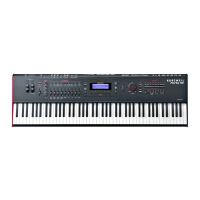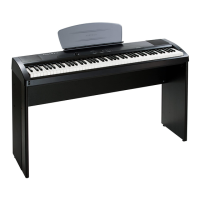Keymap and Sample Editing
Building a Keymap
5-9
Continuing with the example, press the ASSIGN soft button again. Select another sample
root at the prompt, and press the OK soft button. Now trigger F# 1 for the Low Key
prompt, and F 2 for the High Key prompt. At this point you’ve dened two key ranges, the
rst from A 0 to F 1, and the second from F# 1 to F 2. You can repeat the process as many
times as you want, creating a new key range each time.
Once you have your samples assigned, you may need to transpose them so that they play
back at the correct pitch within the range you have chosen. To do this, highlight the Key
Range parameter, scroll to the range you need, then highlight the Coarse Tune parameter.
Adjust Coarse Tune to bring the sample to the proper pitch within that key range. en
scroll back up to the Key Range parameter, select the next range, and continue as needed.
Here’s a fairly important point that may or may not aect your keymap construction.
Suppose you want to build a keymap that uses the same sample in several adjacent key
ranges, and you plan to add a bit of detuning to the samples in each range. You might think
that you could build the keymap rst, then go into the Sample Editor and tweak the sample
settings of each keyrange when the keymap is nished. Yes, but…
Suppose you used the technique we described above to assign a vocal sample whose root was
C4 to a key range from A 3 to E 4. en you assigned the same sample to a key range from
F 4 to B4. You might be surprised to nd that when you nished the F 4–B 4 key range and
the Keymap-editor page reappeared, the current key range would not be F 4 to B 4, but A 3
to B 4! is is because the PC4 automatically merges adjacent key ranges that are identical
(this is done to save memory). erefore, some parameter must be dierent in each adjacent
key range you create if you want to build keymaps using the technique we just described.
So if you want to use the same samples in adjacent key ranges with, for example, minor
pitch or volume modication, you should make those changes to the current sample on the
Keymap-editor page before assigning the next range.

